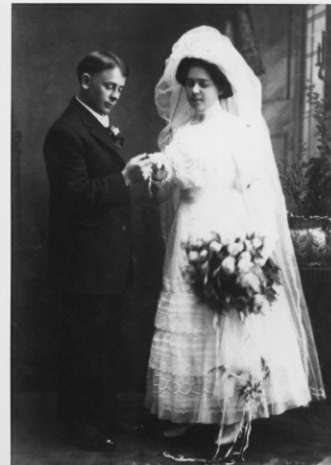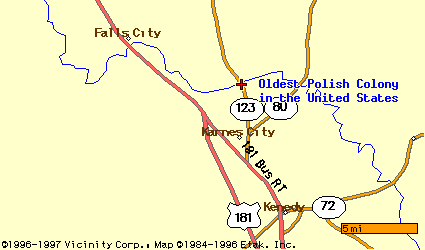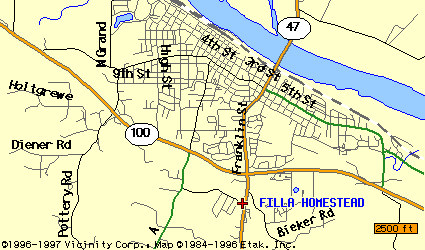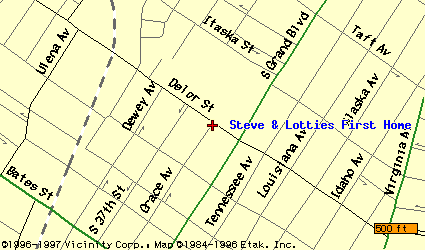
THE STEPHEN FILLA FAMILY HISTORY

Stephen Adam Filla & Wladslava(Lottie)Pisowadzka on Wedding Day, October 25, 1910
My great-grandparents' names were Sobek and Margaretha Filla. They left Poland in the 1850's, coming over the ocean in a "sailing ship". It took them six weeks to make the crossing and landed on the gulf coast of Texas. They had three children, who were also born in Poland; my grandfather, Albert, born April 23, 1839, Andrew, and a girl whose name I do not know. The girl was killed by Mexican bandits who robbed the family while they lived on their homestead in Texas.
Their homestead was about forty miles southeast of the present city of San Antonio. The villages' or towns' names were " Pana Maria", and "Kosciousko". They are still there to the present time. Great-grandfather Sobek, and the other immigrants who came over with them took up farming there, and raised good crops. However. they were considered "nesters" by the big cattle outfits. To get rid of them, they would drive their big cattle herds on their farms to eat up their crops, thereby starving them out. Our people were powerless to defend themselves. There were no fences in those days and law and order were lacking. The settlers decided to leave and started out, not knowing where to go, I would surmise.



Washington, Mo. and Cloverbottom/Krakow Area
They finally arrived in the vicinity of Washington,Missouri and settled south of the village of Washington.After settling there they established a small village, and named it Krakow after their hometown in southern Poland.
The Filla family were people of means, as great-grandfather Sobek brought
$9,000 in gold as their nest egg for their adventure in the New World, as it was
called by them at that time. Needless to say, a New World it was. Great-
grandfather Sobek had the means to buy land for their homestead a number of
miles north of the Clover Bottom Village along the St. John's creek. They built a
rock house from stone quarried on a sloping field on their farm. The livestock
barn, likewise, also was built of stone. The buildings were sturdily built, as the
workmen of those times were good stonemasons. The place is gone now, as it
changed owners a number of times, and Steve Kluba, Aunt Alvina's only living
son, said the house burned down a number of years ago, as a bunch of
"hippies" lived there for some time, then disappeared.
Great grandfather Sobek and Margaretha are buried in the Catholic cemetery in
Krakow, Mo. next to my grandmother, Frances Filla, whose granite monument still
stands there. Great-grandfather and great-grandmother did have a cast iron cross
marker on their graves up to 1939, the date that my cousin Alois Filla last
visited their graves. Time and the elements must have taken its' toll, or maybe
vandals may have had something to do with its disappearance. Harold and I
visited there around 1984 on our way to St. Louis and we walked
around the cemetery trying to find my grandmother, Frances', grave stone. The
ground was wet and saturated from a lot of rain and we were told that the
cemetery had been vandalized recently. I had remembered my father, Steve, always taking me
there to visit his mother's grave and we would always kneel down and say a prayer.
My father was very sentimental about always doing that. He was only three
months old when his mother died. Anyway, Harold had tried to tell me how
hopeless it would be to find it but I talked him into at least trying. As it turned
out he was the one who actually found it and was very excited about it when he did.
I was interested in finding out what it would say as my grandmother's maiden
name was also "Filla". I was told that she and my grandfather were not related
but I know that I had double-cousins; cousins that might be third cousins
from my grandfather's side of the family and these same cousins being second
cousins on my grandmothers side of the family. Seems they should be blood
relatives, my grandfather and grandmother, if only distant ones.
The Filla homestead was inherited by Sobek's son, Andrew, who married a
beautiful Polish maiden named Mary Labus, and lived there most of their married
life until old age, then lived with one of their children in St. Louis. None of their
children stayed on the farm as it was not big enough to support them. Most of
them settled in St. Louis.
My grandfather, Albert,("Voytek" in Polish) was born in Poland April 23, 1839.
He was a young boy when he crossed the ocean with his parents. He grew up on
the original homestead and got work whenever he could to earn some money. When the
Civil War broke out between the States
he joined the Union Army, (The North);
the other was called The South (or Confederate). The army headquarters were
camped at the mouth of the St. John's Creek, west of Washington, Missouri. His
job was being a foot soldier (Infantry, we call it now.) He stayed in the army
until the war ended.
Coming home after the war, he was able to purchase a tract of land about one and
one-half miles from the Village of Clover Bottom. He married a young Polish woman
named Frances Filla (no relation or so they claimed).They had five children;
Louis, Mary (Cierpiot),Alvina (Kluba), Andrew, and Stephen (Steve), who was
my father.
Grandma Frances died in 1882 at the age of twenty nine years. Andrew was
three years old and Steve was three months old. She died of typhoid fever.
Andrew was near death from the same illness. In those days there were no funeral
establishments, so grandpa took team and wagon and drove to Washington to get
a coffin for grandma. He also bought one for Andrew, thinking it would save him
an extra trip, just in case he also died. In retrospect, Uncle Andy's nine
sons and two daughters came close to not being born into this world.
Grandpa had a problem - a bunch of little kids and nobody to take care of
them but as fate would have it, he knew a Polish widow named Hahn with three
daughters who also needed help. Putting 3 and 5 children together, they
got married. After some years together they didn't hit it off too well, so
there was a parting of the ways.
Uncle Louis married one the the girls, Carrie (who also was his stepsister)
though there was no impediment to their marriage. He established a home there,
also for his mother-in-law. Each had a separate house to live in. She died a short
time later. Grandpa made his home with his married daughters, Mary Cierpiot
and Alvina Kluba, for a time but finally made his home at my Uncle Andy's for
a few months, and died December 10, 1912. He is buried in the Catholic cemetery
at Clover Bottom. The funeral cost $75.00. The hearse was a one-horse unit
(pulled by one horse). The funeral director was named Bleckman. The
grave was dug by some of the neighbors, and was done for free, as
was the custom of those days. They also closed the grave right in front of the
mourners, after the commitment prayers were said. Needless to say, it was a
shocking experience for the real young mourners present. There was screaming
and crying when they heard the clods of dirt hit the coffin in the bottom
of the grave.
When grandpa Albert parted company with his second wife and
after Uncle Louis was married to Carrie Hahn, Uncle Louis bought the home
place from grandpa for twelve hundred dollars on credit. Andrew and Steve, (my
father), got their inheritance when they reached the age of twenty-one years.
Five children sharing a twelve hundred dollar inheritance! The heirs did get
their money in due time.
Andrew and Steve worked out between different
farmers, also on railroad and construction jobs. They worked on the International
Shoe Factory building when it was being built in Washington, Mo. Andrew,
Louis, and Mary settled in Washington, Mo. I think Alvina either settled in
Washington or Union, Mo. Steve ventured to St. Louis.
Steve worked for
The Ford Motor Company in St. Louis and was introduced to a beautiful young girl
named Wladislava (Lottie) Pisowadzka, my mother. He was introduced to her by
her brother, Anthony (Tony) Becker and his wife Annie (Sikorski). Lottie had
arrived from Poland approximately two years before meeting Steve. After about
a three month courtship they were married at St. Hedwig Polish Catholic Church
in South St. Louis on October 25, 1910. The reception and dance was held at
Uncle Andy's home place in Washington. A big tent was rented plus 12 inch
pine boards for the dance floor. There was real live Polka dance music by some
of the old time fiddlers from Clover Bottom and plenty of keg beer to quench
everyone's thirst.
My mother told me a little about that 3 month courtship
she had with my papa, as we called him. I think of that as such an
affectionate way to refer to a person's father. How can anyone have a disagreement
with anyone they would call "papa". Back to the courtship---my father
would have a date with Lottie one evening and the next day she would receive a
love letter from him in the mail. What a guy!! He was twenty-nine and she was
twenty-one and he was ready to make a committment to this lady thus his proposal
and their marriage three months later.
Steve and Lottie made their home in South St. Louis near their church, St. Hedwig
which also had a parochial school where they taught the pupils in Polish and
English. I might add, St. Hedwig is the patron Saint of the Polish Nation.
Steve and Lottie lived on Grace Avenue, where he built a small home, converting
a garage into this home.

They planted a garden and raised chickens on this small plot
of land. They had a few good neighbors, especially one I remember visiting
many times, named Mrs. Tiemann but Lottie never felt at home here. Three of
their four children were born on Grace Avenue; Walter on September 6, 1911,
Lucille on July 19, 1913, and Leonard on October 8,1915
See Genealogy Table of Filla Family


by Jeannette (Filla) Shields
 August 6, 2002
August 6, 2002